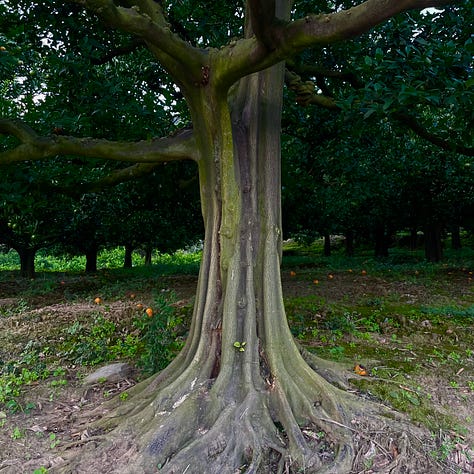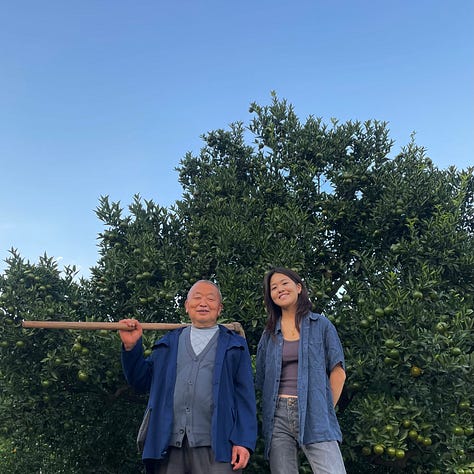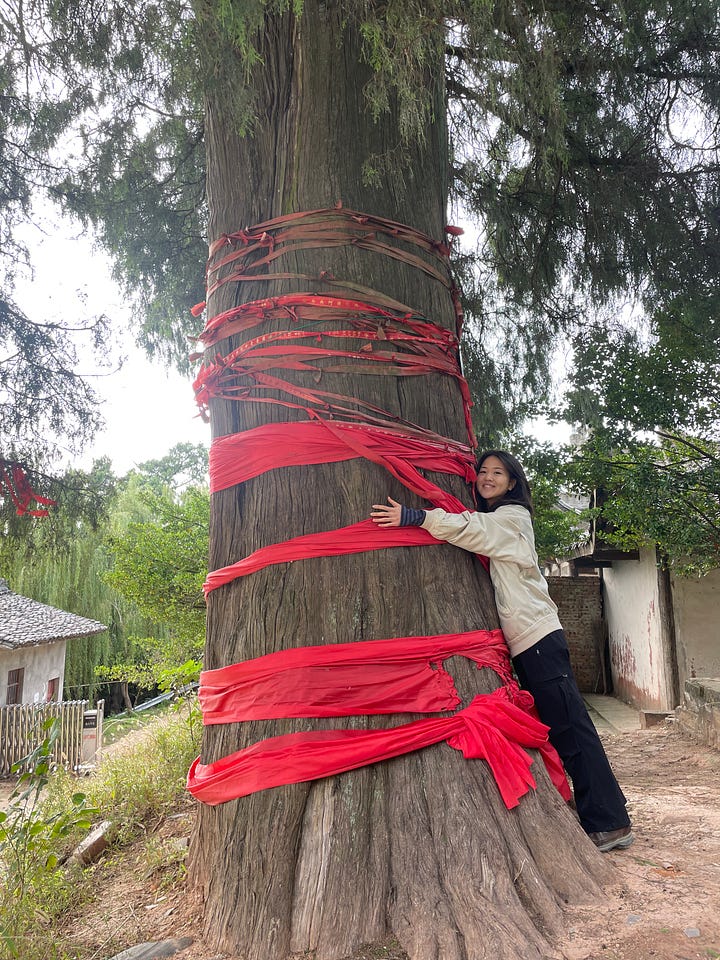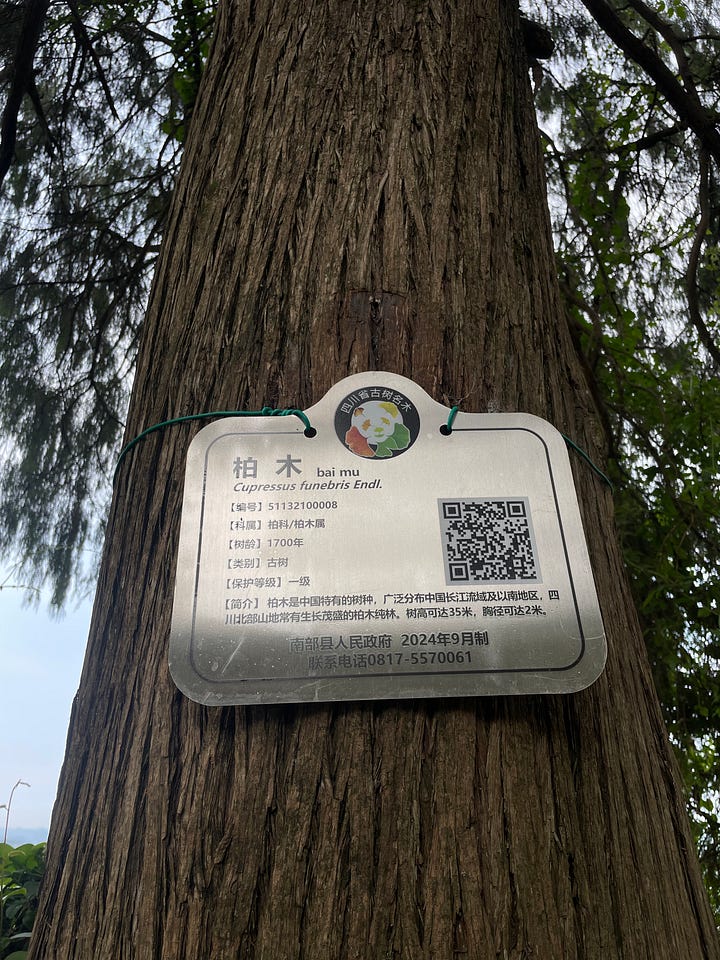Hugging the world's oldest orange tree
Collected reflections on heritage conservation, and what makes it so uniquely difficult in rural China.
This is an extended version of a piece originally written for and posted on my Instagram page @chinesefarmchronicles on 5 January 2025, based on notes and observations I’ve accumulated from various villages throughout the year. I recommend reading this post either in your web browser or the Substack app as it may exceed some email providers’ size limit. (Yes, believe it or not, I have until now been posting these as Instagram captions).
Foreword
I am often met by surprise when I tell Chinese people that I want to research rural China. They usually express something along the lines of ‘well, good luck’ – reminding me that not only is the Chinese countryside immense, but also immensely heterogeneous. And they’re right. I have travelled across 13 provinces this year, and to draw any general conclusions about where things are headed in rural China—what the trends are, which are the significant ones—has often felt like an impossible task. At times, I will think that I have picked up on something in one place, only to then find the opposite happening in another.
But for a month now, I have been at home, in Sweden, resting and spending time with family before embarking on another half-year of travelling. Taking this time to pause, after nine months on the move, has finally given me a chance to make sense of and start to synthesise the observations and experiences I have collected from across places and contexts. This long read, the first one I wrote after coming home, is a product of this reflection. I hope to share many more.
Enjoy,
薇薇
When a wealthy boss in Fujian heard of Mr Zhang's orange trees in Qitian village, he immediately offered up 200,000 yuan to have one dug up and shipped to his private garden.
The last time Mantou and I spoke about this, his moral compass was still flickering. Mantou, a military veteran, law graduate, and former academic now in his late thirties, moved back to his home village Qitian, in Nanbu, Sichuan, five years ago and has since been managing a rural cooperative for elderly smallholder farmers. When we visited Mr Zhang, one of the founding members, we found him in his orchard – tending, as his family has for three generations, to the orange trees his grandfather planted 150 years ago.
“Go hug one,” Mantou said. Sensing my confusion, he went on to explain that the average lifespan of citrus trees is only around thirty to fifty years. These trees, the Chinese Academy of Sciences had recently told him, are therefore likely to be the oldest still fruiting orange trees in the entire world. An educated man and passionate conservationist, Mantou immediately started spreading the word about this wonderful cultural heritage they had uncovered in his home village.
But then people started placing bids.



Figs. 1–3. Me, Mr Zhang, and his 150-year-old orange trees in Qitian village, Nanbu, Sichuan.
Fig. 4. Mr Zhang snipping oranges off his trees.
Fig. 5. Mantou getting camera-ready by wiping some sweat off his forehead.
Mantou was torn, because how do you, and indeed should you, convince a seventy-year-old villager to pass on this immediately life-changing cash – for the sake of something so abstract and, well, intangible, as “intangible heritage”?
Now upon reflection, this has been a recurring dynamic throughout my travels in rural China. Educated youth returning to their home villages with a newfound appreciation for the “old”—old-style houses, old attire, old production methods, or “crafts” as they see it—and yearning to preserve it. And the villagers, meanwhile, just wanting to live more comfortably.
I also thought of when my Tibetan friend Zeren Tashi had taken me on a tour of his semi-nomadic family's old permanent residence – a stone house in the grasslands outside of Tagong, now used mainly for yak dung storage. He had dug out a few artefacts to show me: among them, a traditional Tibetan black yak hair tent called a baku, and a wooden butter tea churn. He told me how yak hair weaving is a dying art; that he, like most young Tibetans today, never inherited the craft from his father. He also said he hasn't used a manual churn to make butter tea since he was a kid. But did he tell me this with a deep sense of regret?
There was nostalgia, for sure. And I suppose just the fact that he had kept all these items and was sharing these stories with some visitor from Sweden, allowing me to now pass them on to you, is quite literally what conservation is about. But Zeren Tashi also talked about how much more convenient and low-maintenance the modern white cloth tents are, that unlike yak hair tents they don’t need such frequent repair, or get outrageously heavy when wet. And that the electric butter tea blenders are pretty cool too.
Fig. 6. Most Tibetan nomads today are semi-nomadic, meaning they move around with their herds only during the summer months and live in permanent settlements during the winter. This is Zeren Tashi’s family’s old stone house, built 48 years ago. They built their new home, a two-storey brick house right by the road a few hundred metres away, fifteen years ago.
Fig. 7. Tibetan nomads traditionally lived in black tents like this one, called a baku in Tibetan, which is made with woven yak hair.
Fig. 8. Yak butter tea is a staple beverage of Tibetans and is made from tea leaves, yak butter, water, and salt. Traditionally, this would be made with a long wooden churn like this one, but these days electric blenders are more common.
Fig. 9. This is the tent that Zeren Tashi’s father and stepmother now live in between July and November each year, when they will be moving around with the family’s yaks and horses, changing sites circa every 20 days.
Fig. 10. Zeren Tashi making yak butter tea in an electric blender.
This is not a new dilemma, either. Also in Mantou's village, there are some majestic 2000-year-old Chinese weeping cypress trees, but I was told there would have been many more had they not been chopped down for firewood when Chairman Mao, during the Great Leap Forward campaign (1958-1962), demanded all peasants to start making steel in their backyards. (See 'backyard furnaces').


Figs. 11-12. Photo of me hugging one of the few ancient Chinese weeping cypress (Cupressus funebris End.) trees in Qitian to survive the Great Leap Forward campaign. It is 1700 years old, 35 metres tall, two metres in diameter, and three and a half times my arm span in circumference.
What prompted me to reflect on these interactions again last night, and most importantly connect them, was a conversation with my good friend Anusha, an Indian filmmaker whom I met on a farm in Sichuan. After five years in rural China, Anusha has for some time now had her eyes on Indonesia for her next project, which would look at how climate change is affecting the coasts of its islands.
I was reading up on some Chinese coastal communities in preparation for an upcoming trip to Hainan island, when I came across a New York Times article I thought might interest her. The piece was about how the Southern Chinese 'Tanka' or 'Boat People', in the process of modernisation, were finding their traditional boat-dwelling lifestyles and fishing practices on the verge of extinction.
I shared the piece with Anusha, and quickly, we discovered that we had both highlighted the same line:
“We have no choice but to hang on to our old way of life, because it’s the only skill we know,” Mr. Chan said. “I don’t want our tradition to be preserved if the younger generation doesn’t want to keep it.”
Fig. 13. Residents of this floating village in Datang are members of the Tanka group, an ancient people scattered across southern China who have survived on coastal waterways (Photo: Lam Yik Fei for The New York Times).
“It's sad that conservation and livelihood have to be mutually exclusive... More so in China,” Anusha said. I asked why she thought “more so in China,” because while I have often sensed unease in China’s relationship with its past, I—much less well-travelled than Anusha—never felt sure whether there was anything uniquely Chinese about it.
Three hours later, she returned with the most eloquent breakdown. I couldn't summarise it any better myself, so with her permission I will share some extracts of it below.
She begins:
“The way I see it, there are two angles to this story. One is the environmental/livelihood aspect, and the second is the historical/cultural aspect. Issue one exists everywhere. Overfishing, extraction of resources, people having to move to the cities for opportunities. It's happening in all countries.
Issue two I feel is more unique to China perhaps because of its history and the Cultural Revolution. I feel like in most of China, traditions exist only if and because they bring money. They either serve the tourism sector, international trade, or have some market value within China.”
This observation from Anusha echoes many of the conversations I have had, both with Chinese people and other foreigners who have spent significant time in China.
The Cultural Revolution was an upheaval launched by the Chinese Communist Party (CCP) Chairman, Mao Zedong, during his last decade in power. It sought to purge all remnants of capitalist and traditional elements from Chinese society through an all-out assault on the so-called ‘Four Olds’—old ideas, old culture, old customs, and old habits—which not only caused extensive social turmoil and cultural destruction, but also, as Anusha rightfully points out, left deep scars in the Chinese psyche. Today, the campaign is widely recognised as a disastrous mistake, both within and outside of China.
Fig. 14. A poster (1967) from the Cultural Revolution, depicting Red Guard youths breaking and throwing away the four old traditions: religion, literature, capitalism, and imperialism. One youth carries a flag with Chairman Mao’s portrait, another holds a placard with the text “Eliminate the four olds, establish the four new”. Image Source: Library of Congress
The CCP’s official party line since Mao Zedong’s death has been that he was “70 per cent correct and 30 per cent incorrect,” which I find is also quite a good summary of the mainstream sentiment. The best illustration I have of what this 70/30 split may look like in practice is an interaction I had in a village in Dazhou, Xuanhan, in northeastern Sichuan.
It was on 重阳节, the Double Ninth Festival, and we had just descended the nearby Wen Mountain in pouring rain when an elderly couple spotted us from their foyer and invited us inside to warm up. Turns out, many years ago, their home was on Wen Mountain.
“Oh, it used to be so beautiful up there,” the man bemoaned, describing in a heavy Xuanhan dialect which I struggled to decipher something about the temples, things shimmering in gold, some nicely built stairs. “But the Cultural Revolution…,” he began, waving a finger.
“The Cultural Revolution, ah! Posijiu, Destroy the Four Olds, ah!” His wife chimed in, louder, to make sure we understood. “That’s when they tore it all down.”
Behind them as this conversation unfolded, an A2-sized portrait of none less than Comrade Mao Zedong.
Fig. 15. An elderly couple in a village in Dazhou, Xuanhan, in the Sichuan Province. They had three posters on the walls of their foyer: one of Xi Jinping and his wife’s 2015 visit to the US on the left, one of Mao Zedong and the Ten Great Marshals of the People’s Liberation Army on the right – and, facing the entrance, Mao Zedong’s portrait. The red text beneath reads “Comrade Mao Zedong”.
Fig. 16. On Wen Mountain helping a local Taoist acupressurist set up a free pop-up clinic for nearby residents, in honour of the Double Ninth Festival. The red structure is a part of 文山庙 (Wenshan temple), also known as 真武宫 (Zhenwu Palace) – an ancient Buddhist temple on Wen Mountain's summit. The site has over 2000 years of history, but its original structure was largely destroyed during the Cultural Revolution and then rebuilt in the reform and opening-up period.
Anusha continues:
“Traditions are rarely valued merely based on personal interest, faith or a genuine love to keep one's history alive. In fact, such people are considered quite backward and outdated. When something is based only on how much money it's gonna make, it becomes hard to sustain. Because people will just move on to the next big thing. That's probably why there's some stigma around this particular community and why some of these folks don't wish to even teach their kids a skill or two.
In contrast, you have similar communities in Brazil or Indonesia, where they all get together and fight for their culture, their land, even at the cost of making more money, because traditions are ingrained in the country and culture. It's easier to resist change when you have the environment to do so. Being a lone saviour, like your tree friend [Mantou], is almost impossible when your surroundings don't support it.”
Here, I suspect Anusha was thinking about one of our friends at the farm, an entrepreneur in his early thirties who often talked about wanting to start a tourism business in his home village. One time, he had turned to us for ideas on how to promote some local customs and traditions to foreigners.
“Oh interesting, what customs? Do you practice any? What makes you interested?” Anusha had asked him.
He thought for a while, then started telling us about these sandals that villagers used to weave with leftover straw from the rice harvest – a dying art, he said, but a few elderly women still know how to make them. Perhaps Anusha could shoot some videos to help him sell these sandals abroad.
Upon this, Anusha just laughed. (Our friend, for context, is not quite the straw-sandal type). “Come on, I know you. You would never even try on a pair of those sandals! How will you be able to convince others to?”
“Then how do you guys do it in India?” He asked. “Tourists are quite eager to buy your traditional attire?”
“Well, maybe because when I go back home, I mainly wear my traditional clothes. Because I genuinely value them,” Anusha explained. “I don’t care if foreigners like it or not. But maybe when they see the culture being alive on a daily basis, they feel inclined to buy some.” She suggested he instead choose something that genuinely interests him. Focus on what you really want to share with the world, she said, and the world will come to you.
In the end, I believe our friend gave up on the tourism idea and started doing import-export business in Guangzhou instead.
Anusha concludes over text:
“But well, I'm sure there are advantages as well. I remember Uncle Qiang once told me that most countries begin with A (traditional) and move to B (modern). Then, they realise B is too much, so they retract and try to find a balance between A and B.
In China, all the A was erased. We have no A, only B. So, we need to find C, D, E. Constantly reinvent and adapt to changing technologies. That's why the country is technologically savvy, because the people are always open to adapt.”
Arriving at the end of this chain of messages, I was glad that it had taken a hopeful turn. Because, despite it all, I do think there are reasons to be hopeful.
Shortly after I left Tagong last summer, Zeren Tashi told me that he had dusted off his father's tent and set up a ‘black tent camping site’ for curious visitors on the grassland outside of their home. Then I heard of a Swiss woman in Chengdu, who works with Tibetan women to make and sell woven yak hair handicrafts. (Anusha has made a film about her!).
Fig. 17. A photo Zeren Tashi sent me on WeChat after I left, of his Black Tent Camping site.
And Mantou is currently pouring his time and savings into developing, under the cooperative's name, a premium brand for chenpi – a type of highly sought-after sun-dried and aged orange peel used in traditional Chinese medicine. Seeing that some chenpi he started ageing eight years ago is already selling for 16,800 yuan per jin, 500 grams, Mantou is confident that this plan, given time, will bring Mr Zhang and the other cooperative members riches way beyond the 200,000 yuan offered by the Fujian boss. Aware however that his elderly comrades may not have much time, he is also giving them immediate, way-above-market-price payment for the oranges out of his own pocket. (Mantou being his own cooperative’s poorest member has become a running joke in the village). And then there is also Mr Yang, another friend of mine from a village in Hunan, who recently told me that he is applying for UNESCO funding to develop and train an AI model – specifically for collecting data on rural culture, production methods and ways of life.
It is so uncertain what China's C, D, and E will look like, but these people make me hopeful that they exist. Hopeful that there is some balance to be found – between thoughtlessly embracing progress, and foolishly clinging onto the past.
Perhaps it looks something like a hug.
Fig. 18. Helping Mantou make chenpi, a type of sun-dried and aged orange peel used in cooking and traditional Chinese medicine. Mantou makes them by scoring a cross in the peel, making sure not to cut into the flesh of the fruit. Then he prises the fruit off, lets the peels rest outside for a few hours, and then folds the petals out to begin the drying process. Most of the leftover fruit is made into orange wine.
Figs. 19-21. Mantou taking the chenpi stores out for their regular sun-drying. Real sun-dried chenpi is rare these days as the drying process requires a lot of space and is very labour-intensive. In the first year of drying, they need to be laid out flat under the sun for at least one day a week.
You can find more of my (shorter) writing, photos, stories, and the occasional reel on @chinesefarmchronicles. Under ‘Kham grasslands’ in my story highlights, you can find more content from my stay with Zeren Tashi – and under ‘Qitian’, from my visit to Mantou’s village and the Qitianren Elderly Farmers’ Rural Cooperative, of which I am now an honorary member. I also post photographs on @vzw.jpg.




















Hey Vivianne, wow this was one of the most illuminating posts I’ve come across on Substack. It was really such a joy to read. Everything, from the friends who welcomed you into their homes and ways of life to the vibrant and touchingly human photographs made me wish I was there traveling and on this journey with you! How lucky I am to get a glimpse of what you see and experience there.
I’ve never been to rural China, nor am I super familiar with Chinese history, so it was very interesting to read about the impact of the Cultural Revolution and rapid progress on cultural heritage and what remains. I also found the whole process of producing the medicinal chenpi, from tending to the hundred year old trees that have been in the family for three generations to the labor intensive removing of the peel and sundrying, to be rather beautiful. I am glad Mantou is invested in continuing this tradition while finding a new path forward. In a world where everything is aimed at efficiency and processes are constantly optimized, it’s nice to see the fruits of older, traditional methods and ways of living, and the people who want to conserve them, even if they too feel the tension and pull towards that which society demands us. I feel like there is a lot we can learn from the slowness and apparent “foolishness” of the past.
You so eloquently weave together these different stories with your own commentary and insights. Very excited to continue to follow along on your journey :)
Thank you so much for this incredible piece--so moved by the images of you hugging the orange and cyprus trees :')